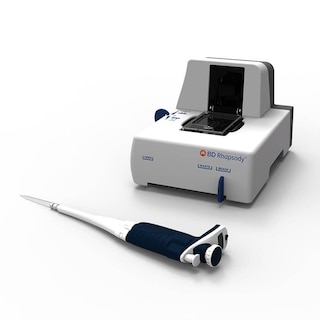-
Your selected country is
Middle East / Africa
- Change country/language
Old Browser
This page has been recently translated and is available in French now.
Looks like you're visiting us from {countryName}.
Would you like to stay on the current country site or be switched to your country?


Oligo Mouse Anti-Human EGF receptor
Regulatory Status Legend
Any use of products other than the permitted use without the express written authorization of Becton, Dickinson and Company is strictly prohibited.
Preparation And Storage
Recommended Assay Procedures
Put all BD® AbSeq Reagents to be pooled into a Latch Rack for 500 µL Tubes (Thermo Fisher Scientific Cat. No. 4900). Arrange the tubes so that they can be easily uncapped and re-capped with an 8-Channel Screw Cap Tube Capper (Thermo Fisher Scientific Cat. No. 4105MAT) and the reagents aliquoted with a multi-channel pipette.
BD® AbSeq tubes should be centrifuged for ≥ 30 seconds at 400 × g to ensure removal of any content in the cap/tube threads prior to the first opening.
Product Notices
- This reagent has been pre-diluted for use at the recommended volume per test. Typical use is 2 µl for 1 × 10^6 cells in a 200-µl staining reaction.
- Source of all serum proteins is from USDA inspected abattoirs located in the United States.
- Caution: Sodium azide yields highly toxic hydrazoic acid under acidic conditions. Dilute azide compounds in running water before discarding to avoid accumulation of potentially explosive deposits in plumbing.
- The production process underwent stringent testing and validation to assure that it generates a high-quality conjugate with consistent performance and specific binding activity. However, verification testing has not been performed on all conjugate lots.
- Illumina is a trademark of Illumina, Inc.
- Please refer to http://regdocs.bd.com to access safety data sheets (SDS).
- Please refer to bd.com/genomics-resources for technical protocols.
- For U.S. patents that may apply, see bd.com/patents.
Companion Products






The EGFR.1 monoclonal antibody specifically binds to the epidermal growth factor receptor (EGF-R). The EGF-R is a transmembrane glycoprotein of approximately 170 kDa that is expressed on most cells. It consists of a glycosylated extracellular domain which binds to epidermal growth factor (EGF), a transmembrane domain, and an intracellular domain with tyrosine-kinase activity essential for signal transduction. The EGF-R plays an important role in the growth and differentiation of many cellular types. Transforming growth factor α (TGFα), vaccinia virus growth factor, and related growth factors can also bind to and signal through the EGF-R.
Development References (5)
-
Fernandez A, Spitzer E, Perez R. A new monoclonal antibody for detection of EGF-receptors in western blots and paraffin-embedded tissue sections. J Cell Biol. 1992; 49(2):157-165. (Biology). View Reference
-
Fitzgerald KA, Callard RE. The cytokine factsbook., 2nd ed. / Katherine A. Fitzgerald ... [et al.].. San Diego: Academic Press; 2001:1-515.
-
Messa C, Russo F, Notarnicola M, Di Leo A. Demonstration of epidermal growth factor receptor in colorectal adenocarcinoma by enzyme immunoassay. Digestion. 1994; 55(2):103-107. (Biology). View Reference
-
Mishima K, Johns TG, Luwor RB, et al. Growth suppression of intracranial xenografted glioblastomas overexpressing mutant epidermal growth factor receptors by systemic administration of monoclonal antibody (mAb) 806, a novel monoclonal antibody directed to the receptor. Cancer Res. 2001; 61(14):5349-5354. (Clone-specific: Flow cytometry, Immunoprecipitation). View Reference
-
Troalen F, Maudelondé T, Montcourrier P, Bohuon C, Delarue JC. Characterization of two monoclonal antibodies against the COOH-terminal part of the human epidermal growth factor receptor and potential clinical use. J Immunol Methods. 1991; 143(2):175-186. (Biology). View Reference
Please refer to Support Documents for Quality Certificates
Global - Refer to manufacturer's instructions for use and related User Manuals and Technical data sheets before using this products as described
Comparisons, where applicable, are made against older BD Technology, manual methods or are general performance claims. Comparisons are not made against non-BD technologies, unless otherwise noted.
For Research Use Only. Not for use in diagnostic or therapeutic procedures.
Report a Site Issue
This form is intended to help us improve our website experience. For other support, please visit our Contact Us page.